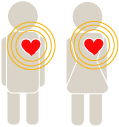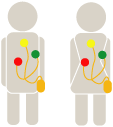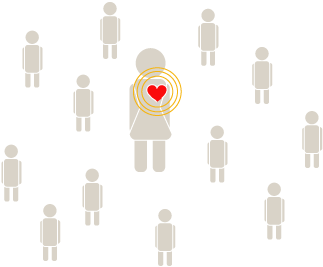

| In their works, authors like William Shakespeare or Rainer Maria Rilke metaphorically picture couples in love as exhibiting the "same heartbeat". Likewise, many of us believe to know this wonderful feeling of having a consonance of hearts, arising from being in love passionately or feeling harmony in partnership. Although often claimed, we do not have empirical evidence of the consonance of heartbeats for people in love. The Research Institute for Pervasive Computing under the direction of Prof. Alois Ferscha has developed a computer program which correlates, compares, visualises, and even sonificates the similarity of heart beats among two persons. | 
|
| Couples in love, people in loose or stable partnerships, but also work or school mates, even casual pickups now have the unique opportunity to see and hear the similarity in their heart beats during the Ars Electronica Festival 2005 at Linz Hauptplatz. While the couple sits down in comfortable chairs in a living room setting, declaring the kind of their relationship using a touch screen, three one-way electrodes attached to their chests monitor their ECG heart activities. | 
|
| First, a graphical visualisation of the cardiogram is shown on wide-screen displays, as well as the similarity among the two people's heartbeats. Simultaneously, a composition by Helmut Rogl takes over the heart beat sounds and allows to listen to the superimposed harmonic rhythm generated from the ECG signals. Participants can browse through the collection of heart beat patterns collected during the Festival, and can perceive pictures of people who would "fit" to them biologically. | 
|
| The mathematical model of ECG signal similarity and the corresponding HEARTBEAT software was especially developed for the Ars Electronic Festival. Biologically, the heart generates and emits electronic impulses, by that controlling the cardiologic system. The agitation's root is the sinuatrial node, a specific spot in the heart's right atrium. This sinuatrial node, also called pulse generator, activates the heart with a particular frequency. The electric impulse reaches the AV-node via the two atriums' musculature, and finally it reaches the two heart ventricles' musculature. The electrical characteristics of the impulse provides an indication how long and how strong the atriums and the heart ventricles are stimulated. The ECG-curve displays both the separate stimulations, as well as the phases between stimulations. | |

|
|
By using electrocardiography the hearts' activities are derived and displayed as an electrocardiogram, which represents the basis of the HEARTBEAT software. More than 3000 hours of software development were used by the HEARBEAT team of Prof. Ferscha to implement the similarity concept, supported by the specialist in internal medicine, Prof. Rainer Schöfl at the Krankenhaus der Elisabethinen Linz. Now the HEARTBEAT software measures the couples' ECG signals, compares these measurements within few milliseconds, calculates mean values, merges the gained data into visual compositions, and expresses harmony in the two signals as a musical intonation. The Research Institute for Pervasive Computing headed by Prof. Alois Ferscha has been active at the Johannes Kepler University Linz since fall 2000. The research activities of the group are focused on pervasive computing systems, i.e. invisible but omnipresent information technologies, embedded into everyday objects ("smart things") and environments ("smart spaces"). HEARTBEAT is the research group's first contribution to the Ars Electronica Festival. If you now want to know whether you and your partner exhibit the "same heart beat", just follow the invitation of the Research Institute for Pervasive Computing to the HEARTBEAT installation at Linz Hauptplatz. The HEARTBEAT-Team welcomes you from September 1st to 6th between 12:00 and 21:00, and on September 2nd und 3rd also from 21:00 to 24:00. Contact: Prof. Alois Ferscha email: ferscha@soft.uni-linz.ac.at www: heartbeat.jku.at |
|